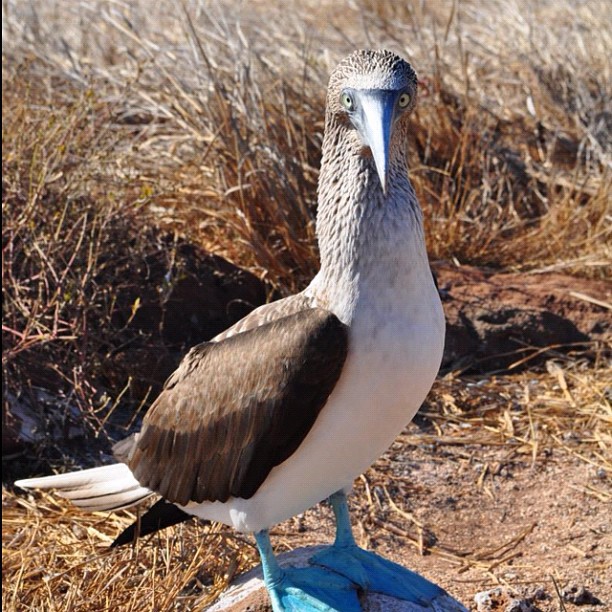Vagabonding Field Report: Visiting the Galapagos islands
Cost/day: $100 to $150 – There aren’t many cheap ways to see the Galapagos
What’s the strangest thing you’ve seen lately?
The Galapagos islands are full of some fascinating and beautiful animals. The most striking part of any trip to the Galapagos however, is how absolutely unafraid the animals are of humans. We walked around the islands as blue footed boobies and frigate birds swirled around us and nested in trees no more than a handful of feet from our reach. As we walked about, they did whatever it was they felt like doing while we snapped photos and peered into their daily lives.
In one particular moment, we were sitting no more than four feet away from a blue footed booby as it was trying to feed its young when all of a sudden a frigate bird swooped in to try and snatch the food being exchanged. I felt the rush of the air from the giant bird’s wings as it swooped down on the boobies. The adult booby fought it off and for the next 10 minutes we watched as it alternated from feeding to fending off attacks from above, all while being completely uninterested in the dozen or so humans standing about watching. It was an amazing feeling to watch a day in the life of these birds without seemingly having any impact on their behaviour.
Describe a typical day:
Sailing around the islands can be done in either day trips or as part of a cruise. We opted for the cruise since it allows you to see a lot more of the islands and explore distances you would not be able to do through day trips alone.
A typical day was fantastic and basically heaven. You wake and have breakfast. You’ll grab your sandals or hiking boots and head for shore to explore one of the islands. Usually it’s an hour or two hiking along a well identified path to take in the wildlife before returning to the boat to get ready for your morning snorkel.
Usually mornings were for deep water snorkelling where you’ll see sea lions, sea turtles, schools of fish and, if you’re lucky, a shark or two. Being in the waters in the Galapagos is not like anything you’ve ever tried before however. Sea lions will often swoop by and give a playful toss or roll as they go about their lives. Sea turtles float by with only a casual concern for your presence. It’s incredible.
After lunch, there’s usually a couple of hours sailing before landing on another island where you’ll repeat the process of hiking and snorkelling again. Life is tough.
In the evening, you’re usually pretty exhausted from all the luxury so you’ll head to bed early after dinner or share a few games of cards with your fellow travellers.
Describe an interesting conversation you had with a local:
After the Galapagos, we headed back to Quito and then south to Banos. We met a fellow in Banos who was working on his PhD and was studying the culture and languages of a few tribes in the Amazon region. After a bit of chatting, he told us about the tribe and how a Spanish TV show had setup a Survivor like gameshow in the Amazon and staged the show with the tribe.
He described how the show had paid large amounts of money to the leaders of the tribe and how they staged the show to give the impression of the tribe as being savages that didn’t wear clothes (they did but were asked not to during the filming) or speak Spanish (again, they did speak Spanish but were asked not to during the filming). He described the ways in which the TV executives took advantage of their ignorance and left behind “modern” appliances like washers and dryers and such and how useless they were after the generators ran out of energy.
It reminded me about how often native cultures put on a show for “modern” travellers to give false impressions with the intention of appearing “savage” or “backwards”. It also made me consider the similarities that a TV audience shares with a local travelling audience. I had never considered watching TV to be like travelling (and still don’t) but the effect of the TV on the local tribes was no different than the effect that tourists have in many ways. They both want to see the “true life” experiences in short “authentic” snippets and for the local tribe, I imagine the effect is the same regardless.
What do you like about where you are? Dislike?
Ecuador has some beautiful terrain with the Galapagos being the crown jewel. Inland, away from the coast, the country is extremely mountainous and beautiful. Hiking provides for some stunning scenery and every little town you stop in will have plenty of surrounding beauty to keep you occupied for days.
As for dislikes, Ecuador has not provided much excitement in terms of food selection. Most meals are starch based (rice, potatoes and often both) with some chicken is how you’ll spend most of your meals. There is more to it than that of course, but the food has tended to be bland which was expected but does make one crave for variety, spice and vegetables.
Describe a challenge you faced:
The one challenge that I’m still facing is with the language. My Spanish is weak and in South America, there is little in the way of English speakers. Communicating with locals has been difficult.
What new lesson did you learn?
If you wish to travel through South America, a little bit of Spanish is really helpful. I’m picking it up as I go but slowly. Worth learning a bit before you arrive to help that process along.
Where next?
Continue south through to Peru.


Category: South America, Vagabonding Field Reports